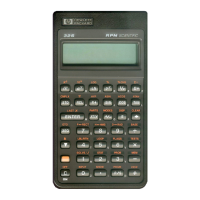When a number appears in
hexadecimal,
octal,
or binary base, it is
shown as a right-justified integerwith up to 36 bits (12octaldigitsor
9 hexadecimal digits). Leading zeros are not displayed, but they are
important because they indicate a positive number. For example, the
binary representation of
12510
is displayed as:
1111101
which is the same as these 36 digits:
000000000000000000000000000001111101
Negative
Numbers
The leftmost (most significant or 'highest') bit of a number's binary
representation is
the
sign bit; it is set (1) for negative numbers. If there
are (undisplayed) leading zeros, then the sign bit is 0 (positive). A
negative number is the 2's complement of its positive binary number.
Keys:
546HrBAsT| {HX}
W
BASE!
{BN}
GDGU
BASE]
{DEC}
Display:
Description:
222
Enters a positive, deci
mal
number;
then
converts
it
to
hexadecimal.
FFFFFFDDE
2's complement (sign
changed).
110111011110
111111111111
-546.0000
Binary version;
*•"
indicates more digits.
Displays the leftmost
window;
the
number
is
negative since
the
highest bit is 1.
Negative decimal
number.
148
10:
Base
Conversions
and
Arithmetic

